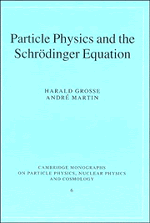1 - Overview
Published online by Cambridge University Press: 13 October 2009
Summary
Historical and phenomenological aspects
The Schrödinger equation was invented at a time when electrons, protons and neutrons were considered to be the elementary particles. It was extremely successful in what is now called atomic and molecular physics, and it has been applied with great success to baryons and mesons, especially those made of heavy quark–antiquark pairs.
While before World War II approximation methods were developed in a heuristic way, it is only during the post-war period that rigorous results on the energy levels and the wave functions have been obtained and these approximation methods justified. Impressive global results, such as the proof of the ‘stability of matter’, were obtained as well as the properties of the two-body Hamiltonians including bounds on the number of bound states. The discovery of quarkonium led to a closer examination of the problem of the order of energy levels from a rigorous point of view, and a comparison of that order with what happens in cases of accidental degeneracy such as the Coulomb and harmonic oscillator potentials. Comparison of these cases also leads to interesting results on purely angular excitations of two-body systems.
Who among us has not written the words ‘Schrödinger equation’ or ‘Schrödinger function’ countless times? The next generation will probably do the same, and keep his name alive.
Max BornBorn's prediction turned out to be true, and will remain true for atomic and molecular physics, and — as we shall see — even for particle physics.
- Type
- Chapter
- Information
- Particle Physics and the Schrödinger Equation , pp. 1 - 22Publisher: Cambridge University PressPrint publication year: 1997

